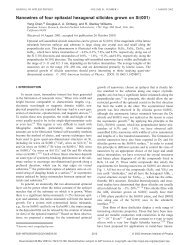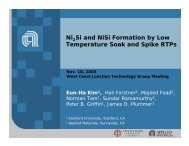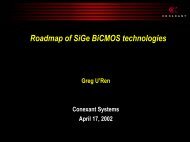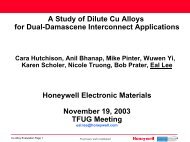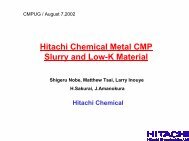Design specific variation in pattern transfer by via/contact etch ...
Design specific variation in pattern transfer by via/contact etch ...
Design specific variation in pattern transfer by via/contact etch ...
You also want an ePaper? Increase the reach of your titles
YUMPU automatically turns print PDFs into web optimized ePapers that Google loves.
Etch Model<br />
� Etch model, represent<strong>in</strong>g mathematical formulation<br />
of <strong>etch</strong> mechanism, provides a relation between<br />
fluxes of all <strong>etch</strong>-important species com<strong>in</strong>g to any<br />
po<strong>in</strong>t at the <strong>etch</strong>ed surface and the <strong>etch</strong> rate at this<br />
po<strong>in</strong>t.<br />
Example of model<strong>in</strong>g SiO 2 Etch <strong>by</strong> Fluorocarbon Plasmas<br />
CF x radical fluxes result <strong>in</strong> SiO 2 <strong>etch</strong> and C xF y polymer deposition<br />
O-atom flux is a major cause of the polymer removal<br />
Precursors for the <strong>etch</strong> reactions are formed at the polymer-SiO2 <strong>in</strong>terface<br />
<strong>by</strong> ion-<strong>in</strong>duced energy reactions: “-Si-O-” + E = “Si-” + “O-”. Energy flux<br />
reach<strong>in</strong>g the <strong>in</strong>terface is controlled <strong>by</strong> the polymer thickness.<br />
Radical reactions between Si- and O- from SiO 2 and F and C from gas<br />
phase and polymer layer are responsible for the silicon oxide <strong>etch</strong><br />
Reaction K<strong>in</strong>etics<br />
x C is the carbon fraction <strong>in</strong> C xF y polymer layer;<br />
θ is the fraction of precursors formed at the SiO 2 -<br />
polymer <strong>in</strong>terface<br />
Η CxFy is the thickness of polymer layer.<br />
Copyright ©2008, Mentor Graphics.<br />
14



